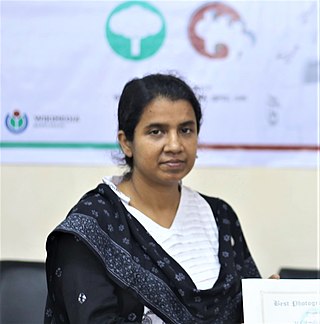Taslima Akhter
Bangladeshi activist and photographer From Wikipedia, the free encyclopedia
Taslima Akhter (born 1974) is a Bangladeshi activist and photographer. She is a graduate of Dhaka University, as well as the photography school Pathshala. She is a member of several activist organizations. While documenting the Rana Plaza collapse in 2013, she took a photograph of a woman and a man who had died in each other's arms, which became emblematic of the incident.
Taslima Akhter | |
|---|---|
 Taslima Akhter at a Wikimedia Bangladesh event (May 2019) | |
| Born | 1974 (age 50–51) Dhaka, Bangladesh |
| Alma mater | Dhaka University |
| Occupation(s) | activist and photographer |
| Notable work | Final Embrace |
| Website | taslimaakhter |
Biography
Taslima Akhter was born in Dhaka, in Bangladesh, in 1974.[1] Akhter is a graduate of Dhaka University, with Master's degrees in science and in public administration.[2] While at the university, she was a member of the Bangladesh Student's Federation.[2] She went on the study photojournalism at Pathshala,[2] a photography school in Dhaka, which was founded by Shahidul Alam.[3] She tries to bring attention to social and environmental issues through her photography, driven partly by her experience during the 2008 political emergency in Bangladesh.[2] Akhter was among those who documented the fire at Tasreen Garments factory in 2012.[2] Akhter has worked on projects in several cities in Bangladesh, as well as in Nandigram in India.[2] Her work led to her receiving the Magnum Foundation scholarship in 2010.[1] Her work has been exhibited in several countries.[1]
Akhter is a member of the women's organization Biplobi Nari Sanghati and the leftist activist group Gana Sanghati Andolan.[3] She is also a coordinator of the Garments Sramik Sangathan (garment worker's union).[1][2] In addition, she teaches at Pathshala.[3] Akhter's politics have an influence on her photography.[3]
"Final Embrace"
Following the Rana Plaza collapse in April 2013, Akhter and other photographers from Pathshala tried to document the lives of people who had died there,[3] while also taking part in the rescue effort.[2] These stories were later published as a book, titled Chobbish April: Hazaar Praner Chitkar (24 April: outcries of a thousand souls).[3] The publication was related to Akhter's work with the garment workers' union.[2] During this process, Akhter photographed a man and woman who had died in the building collapse, locked in an embrace with each other.[4] Akhter was unable to identify the subjects of the photograph despite much effort.[5] [6] This photograph, known variously as the "Eternal Embrace",[4] the "Death of A Thousand Dreams",[7] and the "Final Embrace",[8] received widespread critical attention and multiple awards, and became emblematic of the incident, in which 1100 people died.[4] The photograph also received widespread attention online, and led to petitions to clothing companies demanding higher minimum wages and improved safety standards.[4] Akhter described herself a being haunted by the photograph.[4][5]
Awards
- Third prize for documentary photography at the Julia Margaret Cameron Award, for her documentary The Life and Struggle of Garment Workers (2010).[1]
- Time magazine's "Top 10 Photos of 2013" for "Final Embrace" (2013).[1][9]
- Best Photographer Award from the 5th Dali International Photography Exhibition in China (2013).[1]
- Third prize for single photos in the "Spot News" category, World Press Photo competition, 2014.[10]
- Begum Rokeya Padak (2024).[11]
References
External links
Wikiwand - on
Seamless Wikipedia browsing. On steroids.
